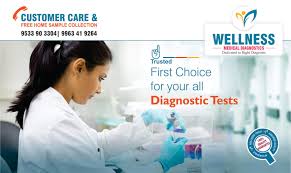Unlocking the Key to Preventive Health
Health is not just the absence of disease—it is a state of complete physical, mental, and emotional well-being. In recent years, the focus of healthcare has shifted from treating illnesses to preventing them before they occur. This is where wellness diagnostics plays a crucial role. By using advanced screenings, tests, and assessments, wellness diagnostics provides insights into a person’s overall health, helping individuals make informed lifestyle choices and prevent potential health risks.
What Is Wellness Diagnostics?
Wellness diagnostics refers to a comprehensive approach that uses medical tests, screenings, and tools to assess an individual’s health status. Unlike conventional diagnostics that primarily detect diseases after symptoms appear, wellness diagnostics focuses on early detection, risk assessment, and preventive care.
These evaluations often go beyond routine medical check-ups. They include advanced laboratory tests, genetic screenings, lifestyle assessments, and even digital monitoring tools that give a holistic picture of a person’s well-being.
Why Is Wellness Diagnostics Important? easy

In today’s world, chronic conditions like diabetes, heart disease, and obesity are on the rise—often due to sedentary lifestyles, poor diets, stress, and environmental factors. Many of these conditions develop silently over years without noticeable symptoms.
Wellness diagnostics helps in:
- Identifying risks early before they develop into serious conditions.
- Personalizing healthcare based on unique genetic, biological, and lifestyle factors.
- Empowering individuals to take proactive steps toward healthier living.
- Reducing healthcare costs by preventing diseases rather than treating them.
Key Areas of Best Wellness Diagnostics
1. Biometric Screenings
Basic health indicators such as blood pressure, cholesterol levels, blood sugar, and body mass index (BMI) are measured to evaluate cardiovascular and metabolic health.
2. Genetic Testing
DNA-based diagnostics can identify hereditary risks for conditions like cancer, diabetes, or Alzheimer’s disease. This allows for tailored prevention strategies.
3. Nutritional and Metabolic Assessments
Tests to evaluate vitamin deficiencies, food intolerances, and metabolic efficiency help create personalized nutrition plans.
4. Hormonal and Stress Analysis
Cortisol and hormone level testing can detect imbalances affecting energy, mood, sleep, and weight management.
5. Fitness and Performance Assessments
Advanced diagnostic tools measure muscle strength, endurance, flexibility, and cardiovascular fitness, guiding safe and effective exercise plans.
6. Mental and Emotional Health Assessments
Psychological screenings identify stress, anxiety, or depression, promoting early intervention for mental wellness.
7. Digital Health Monitoring
Wearable devices and apps track sleep, heart rate, physical activity, and daily habits, offering real-time insights into lifestyle and health trends.
Benefits of Wellness Diagnostics
1. Early Detection of Health Issues
Conditions like high blood pressure or prediabetes can be identified before they cause major damage.
2. Personalized Health Plans
Wellness diagnostics helps create customized nutrition, exercise, and stress management strategies that suit an individual’s unique body and lifestyle.
3. Improved Quality of Life
By preventing illness and promoting well-being, individuals experience better energy, focus, and overall vitality.
4. Motivation for Lifestyle Changes
Objective data from tests often encourages people to adopt healthier habits like balanced eating, regular exercise, and stress reduction.
5. Long-Term Health Savings
Investing in preventive diagnostics reduces the need for costly treatments later in life.
Who Can Benefit from Wellness Diagnostics?
Wellness diagnostics is beneficial for people of all ages and lifestyles:
- Young professionals looking to manage stress and prevent burnout.
- Middle-aged adults aiming to monitor risks for lifestyle-related diseases.
- Seniors who want to maintain vitality and independence.
- Athletes and fitness enthusiasts seeking to optimize performance.
- Companies offering employee wellness programs to boost productivity and reduce absenteeism.
Integrating Wellness Diagnostics into Daily Life
The insights from wellness diagnostics are only effective if followed by meaningful action. Here’s how individuals can integrate them into daily routines:
- Regular Check-Ups: Schedule annual or biannual wellness diagnosticsassessments.
- Balanced Nutrition: Use diagnostic results to adjust diet according to deficiencies and intolerances.
- Exercise Programs: Tailor workouts to fitness assessments and health needs.
- Stress Management: Incorporate mindfulness, meditation, or breathwork if stress markers are high.
- Follow-Up Tests: Track progress and adjust plans as health evolves.
The Future of Wellness Diagnostics
Technology is rapidly advancing the field of wellness diagnostics. Wearables, AI-driven health apps, and telemedicine are making personalized health monitoring more accessible than ever. In the near future, individuals will be able to continuously track key health markers, receiving instant feedback and tailored recommendations.
This proactive approach shifts healthcare from “disease care” to true health care, empowering people to take control of their wellness journey.
Final Thoughts
Wellness diagnostics is more than just a medical check-up—it is a roadmap to long-term health and vitality. By providing deep insights into physical, mental, and emotional well-being, it helps individuals take preventive action, adopt healthier habits, and enjoy a better quality of life.
In an age where lifestyle diseases are common, investing in wellness diagnostics is one of the smartest steps you can take for yourself and your loved ones. It is not worst just about adding years to life but also adding life to years.
